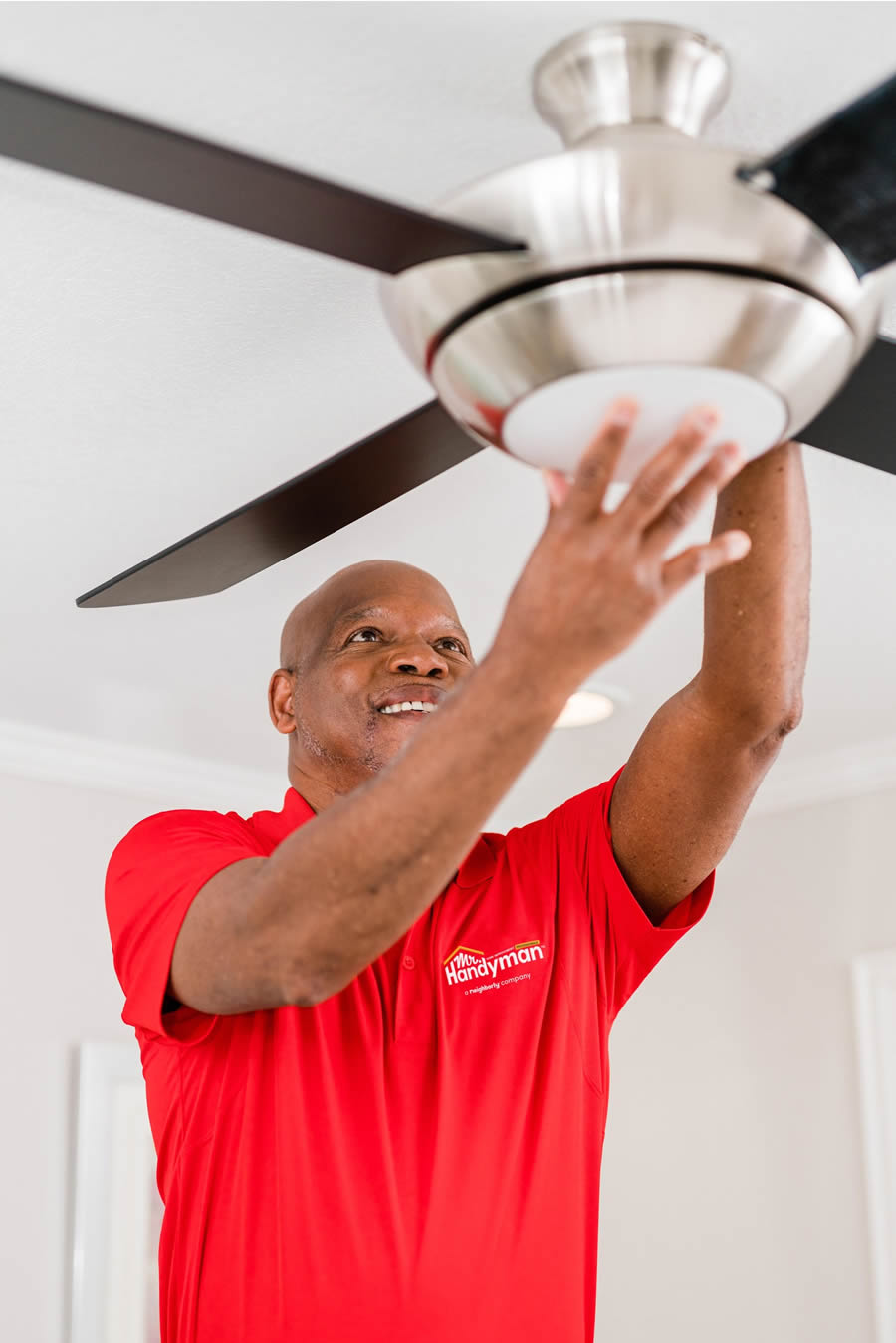Call This Saturday to Get $25 OFF
Schedule Professional Handyman Services Today
Call This Saturday
to Get
$25 OFF
Call This Saturday to Get $25 OFF
Schedule Professional Handyman Services Today
Call This Saturday
to Get
$25 OFF
Besides cooling your indoor spaces, ceiling fans enhance aesthetic appeal and tie the entire design together. If you have a home remodel scheduled or are looking to upgrade old units, choosing the right fan size is crucial. At Mr. Handyman, we understand the intricacies of different ceiling fan styles, ensuring you choose the right system for your comfort and efficiency needs. Our technicians leverage extensive expertise and industry experience, giving you peace of mind knowing every aspect of the job is done correctly the first time. Here’s a detailed breakdown on how to pick the perfect ceiling fan size.

The first step to a successful ceiling fan replacement is to accurately measure your room. This often includes finding the length, width, and calculating the entire square footage you want to cool. While the process may seem straightforward, ignoring this step can lead to inefficiencies, high energy use, and malfunctions. If you prefer a more hands-off approach, hire a professional handyman service in Newtown, PA to help navigate the process successfully.
Ceiling fans come in different sizes to suit various room sizes and cooling needs. According to industry experts, the recommended blade span of a ceiling fan depends on the square footage. After accurately measuring your room, use the results to find the ideal size for optimal functionality and efficiency. For smaller rooms of up to 75 square feet, a 29-36-inch fan span is ideal. However, larger rooms that range over 75 feet require a blade span of 36-144 inches. If your space is more than 400 square feet, reach out to a reputable handyman for the right fan size to effectively circulate air.
Another vital factor to consider before undertaking a ceiling fan replacement project is the height of your ceiling. Open-room concept spaces or great rooms with ceilings over 8 feet high may require a downrod to lower the fan closer to the living area for more effectiveness without risking safety hazards. Conversely, lower ceilings below 8 feet can benefit from hugger-mount or low-profile fans. These fixtures sit close to the ceiling, making them a good option if you want to maintain headroom and prevent head bumps.
Finally, bigger is often better when it comes to ceiling fans. A slightly larger unit will move slowly and circulate more air than small fans spinning at high speeds, and make more noise. In addition, prioritize your preferences to maximize comfort and achieve the desired result. While there are guidelines for choosing fan size, your personal comfort preferences and room layout will influence your decision.
Rust, a broken door, loose hinges, or a leaning post can make your mailbox unreliable. Since it sits…
Read MoreA new TV is always fun until you need to figure out where it belongs. Leaving it on…
Read MoreDaily use takes a toll on steps and stairs. The creaks, wobbles, or cracks that show up might…
Read MoreFor families with kids, aging parents, or frequent guests, railings keep activities safe. Mr. Handyman works with homeowners…
Read MoreColor has a powerful effect on how a space feels. A fresh coat of paint can brighten a…
Read MoreWalk up to any house and your eye catches the trim before almost anything else. Around the garage,…
Read MoreAdding a storm door gives your entry a finished look and protects it from wind, rain, and extreme…
Read MoreElectrical work requires extensive expertise, and ceiling fan installation is no exception. If you are considering a DIY approach, don’t! Here’s why you should hire a reputable handyman.
Whether installing a new ceiling fan or replacing an old unit, safety is a top priority. Working with electric wires poses serious risks, such as electrocution, shocks, or fire hazards if handled incorrectly. A trusted handyman can ensure your fan is securely anchored to the electrical box for optimal functionality and safety.
Handymen leverage extensive industry knowledge to handle tricky installations, such as those requiring specialized brackets, downrods, and other equipment. In addition, they have access to specialized tools that allow them to work at heights and balance installation, preventing weird noises and wobbling down the line.
If you want to enjoy comfortable and efficient living spaces, contact Mr. Handyman to book a consultation with our experts. We go the extra mile to ensure your new unit is secure and reliable for long-term use without breaking the bank.
As a homeowner, dealing with flood damage can be a nightmare. Whether it is from a leaking pipe, rain, or a…
Read MoreCloset issues usually start innocently and escalate over time into drawers full of junk or piles of shoes and other items…
Read MoreA piece of wooden furniture in a landfill or next to the dumpster is not an uncommon sight. While it is…
Read MoreDo you have a home remodel scheduled? Are you looking to revamp your tile surfaces without breaking the bank? Well, you…
Read More